Intel Pentium Silver J5005 Benchmarks
For this exercise, we are using our legacy Linux-Bench scripts which help us see cross-platform “least common denominator” results we have been using for years as well as several results from our updated Linux-Bench2 scripts. At this point, our benchmarking sessions take days to run and we are generating well over a thousand data points. We are also running workloads for software companies that want to see how their software works on the latest hardware. As a result, this is a small sample of the data we are collecting and can share publicly. Our position is always that we are happy to provide some free data but we also have services to let companies run their own workloads in our lab, such as with our DemoEval service. What we do provide is an extremely controlled environment where we know every step is exactly the same and each run is done in a real-world data center, not a test bench.
We are going to show off a few results, and highlight a number of interesting data points in this article.
Python Linux 4.4.2 Kernel Compile Benchmark
This is one of the most requested benchmarks for STH over the past few years. The task was simple, we have a standard configuration file, the Linux 4.4.2 kernel from kernel.org, and make the standard auto-generated configuration utilizing every thread in the system. We are expressing results in terms of compiles per hour to make the results easier to read:
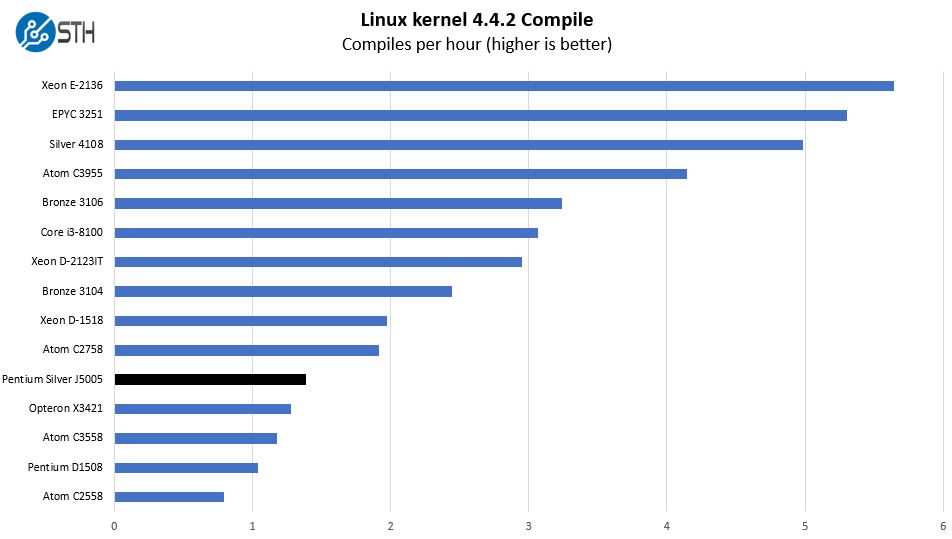
Here we can see solid performance just above what we saw with the original Goldmont architecture represented by the Intel Atom C3558. The Intel Atom C3558 suffers from a maximum clock speed of 2.2GHz in comparison to the maximum clock on the Intel Pentium Silver J5005 of 2.8GHz.
c-ray 1.1 Performance
We have been using c-ray for our performance testing for years now. It is a ray tracing benchmark that is extremely popular to show differences in processors under multi-threaded workloads. We are going to use our 4K results which work well at this end of the performance spectrum.
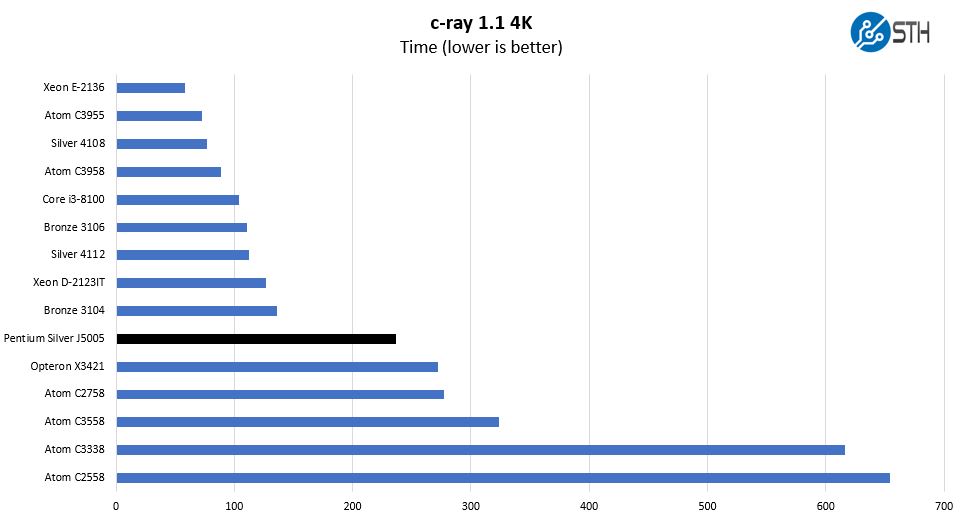
Here you can see that the four core Intel Pentium Silver J5005 performs well against the eight core Intel Atom C2758. That shows just how much advancement the Intel Atom team is making. The Atom C2758 had a more robust feature set with items like QAT and multiple MACs. At the same time, the Atom C2758 had twice the TDP at 20W.
7-zip Compression Performance
7-zip is a widely used compression/ decompression program that works cross-platform. We started using the program during our early days with Windows testing. It is now part of Linux-Bench.
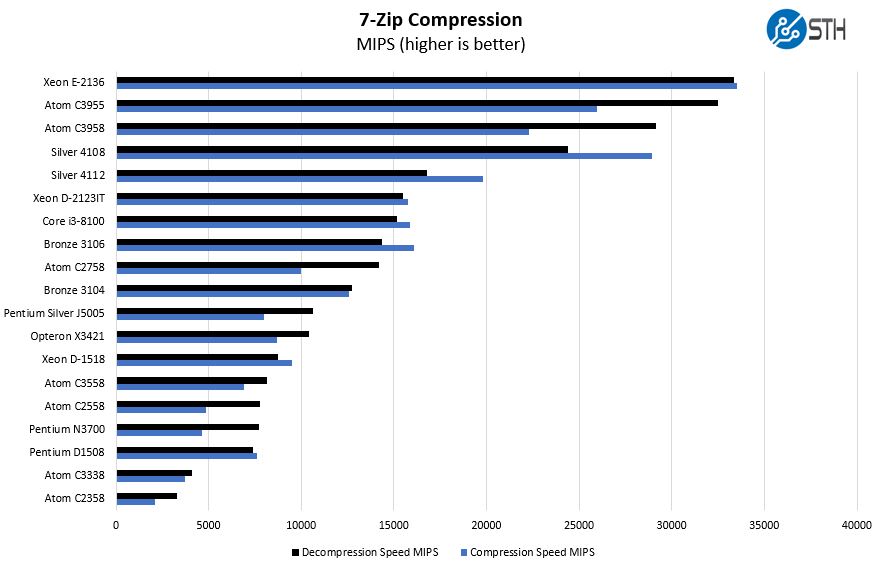
Here we have some absolutely great performance. We wanted to point out that the performance is about on par with the AMD Opteron X3421 in this case and many others. The AMD Opteron X3421 has features such as more PCIe 3.0 lanes, but these products are somewhat competitive.
NAMD Performance
NAMD is a molecular modeling benchmark developed by the Theoretical and Computational Biophysics Group in the Beckman Institute for Advanced Science and Technology at the University of Illinois at Urbana-Champaign. More information on the benchmark can be found here. Here are the comparison results for the legacy data set:

We normally augment this with our GROMACS workload, however, we are going to skip that in this review. With GROMACS we support AVX-512 and AVX2 but these chips are not targeted at this kind of workload. The Pentium Silver J5005 here falls just between the Pentium D1508 (2C/4T) and Atom C2758 (8C) parts.
Sysbench CPU test
Sysbench is another one of those widely used Linux benchmarks. We specifically are using the CPU test, not the OLTP test that we use for some storage testing.
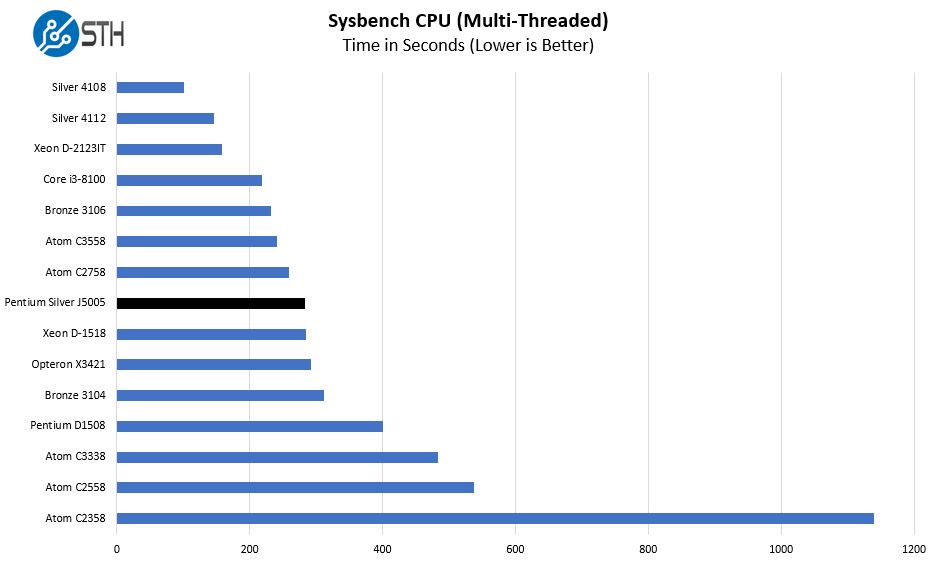
This is another great result which is helped by the benchmark size and the higher clock speed of the Intel Pentium J5005.
OpenSSL Performance
OpenSSL is widely used to secure communications between servers. This is an important protocol in many server stacks. We first look at our sign tests:
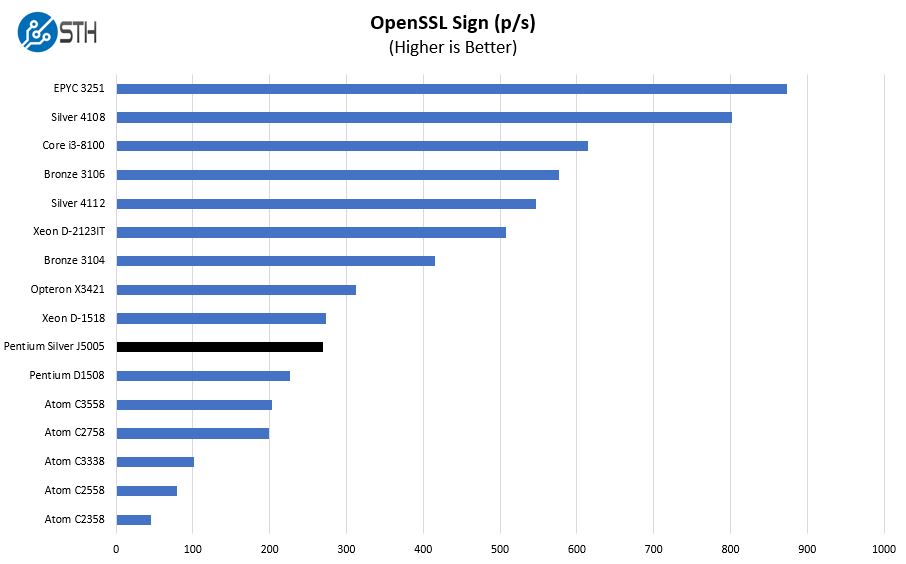
And the verify results:
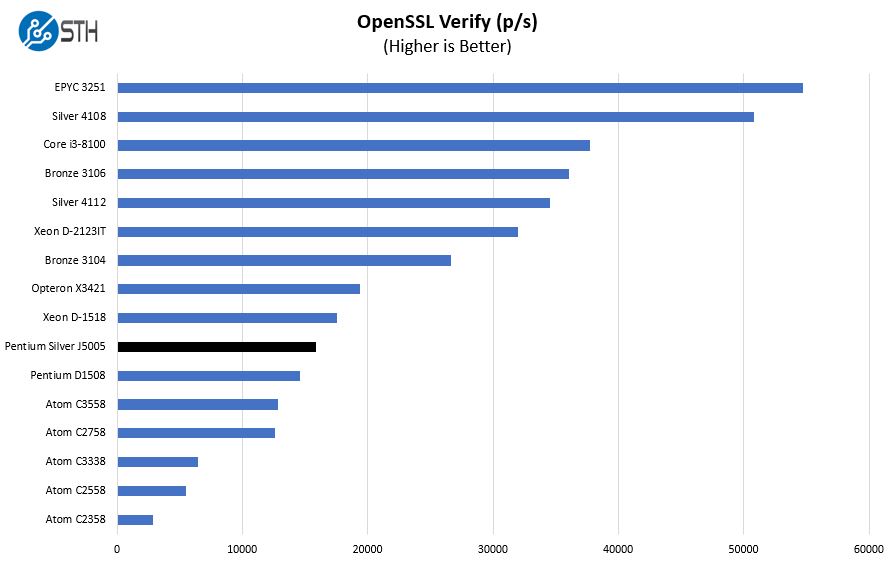
As you can see, the overall performance is very good for a 10W TDP part. Cutting a lot of the I/O from the platform yields TDP dividends which in turn helps CPU performance.
UnixBench Dhrystone 2 and Whetstone Benchmarks
Some of the longest-running tests at STH are the venerable UnixBench 5.1.3 Dhrystone 2 and Whetstone results. They are certainly aging, however, we constantly get requests for them, and many angry notes when we leave them out. UnixBench is widely used so we are including it in this data set. Here are the Dhrystone 2 results:
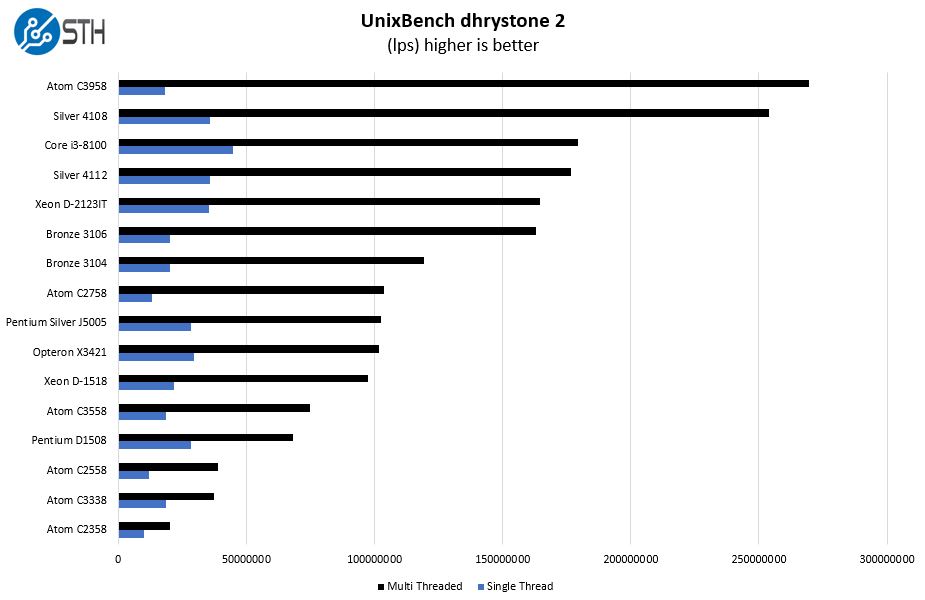
Here are the whetstone numbers:
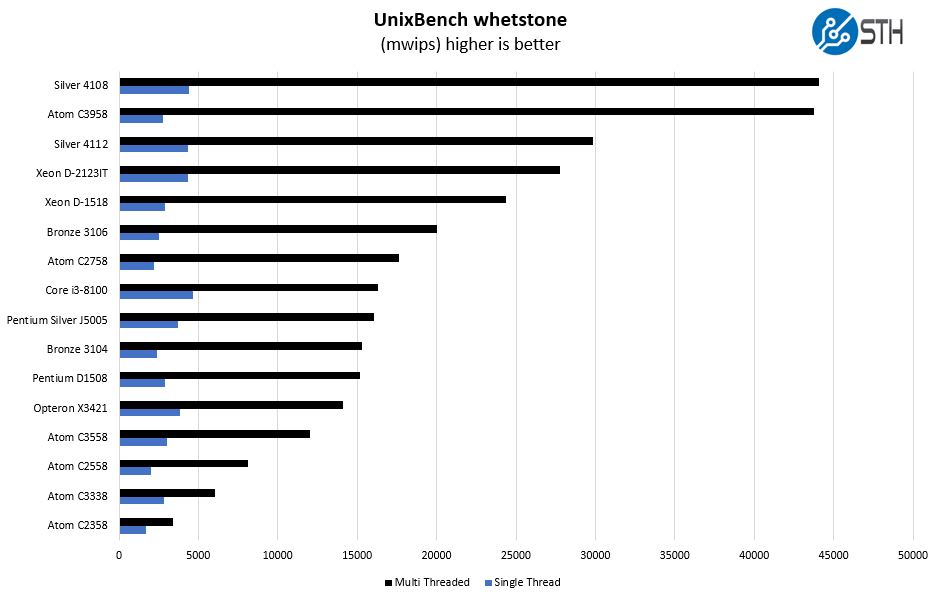
Overall, these are good results. We see performance just above the AMD Opteron X3421 which is a welcome result.
Chess Benchmarking
Chess is an interesting use case since it has almost unlimited complexity. Over the years, we have received a number of requests to bring back chess benchmarking. We have been profiling systems and are ready to start sharing results:

Here we wanted to point out that as good as the Intel Pentium Silver J5005 is, the $161 price tag is steep. In comparison, the Intel Core i3-8100 is less expensive and offers significantly more performance. There is a premium for going fanless with a low TDP.
Next, we are going to have the power consumption, market positioning, and our final words.




Patrick, why do you always write “Python Linux 4.4.2 Kernel Compile Benchmark”? What does python have to do with compiling the Linux kernel?
Hi Marcelo B. This is the second version of our Linux Kernel Compile benchmark that was one of the first ones we launched via a Python setup script. It is just a label to differentiate this versus our older one.
@ Author,
The $161 is basically a placeholder for CPUs like these. The Asrock J5005 motherboard with the J5005 chip integrated costs $119 in Newegg, which is same as what the i3 8100 goes for at the same site.
Consumer level tests show 30-40% gain over the Goldmont predecessor due to significant uarch changes. I’m surprised the gain is less compared to the C3558.
Any idea where to get about 3 dozens of these?
cant seem to find it online, the websites that list this restrict buyers to their customers and i can’t even register.
Our review of the platform is in the final editing stages and hopefully today/ tomorrow it will go live.
Your best bet is to call a Fujitsu reseller.
https://www.impactdisplaysolutions.com/ Their website is currently down but I was on it yesterday. They sell them. Price looks to be around $180 for the mobo so I’m not sure its a good value compared to the ODROID-H2
When will intel start manufacturing this CPU? No where has it in stock.
ASRock is selling a Mini-ITX board based on the J5005.
The have been impossible to get for over a year, but recently I have found some supplies, tested an initial one and then bought three more. The main purpose was to build a silent and low-power oVirt three node hyperconverged cluster with a ‘remote’ backup in the home-lab for concept testing.
The real crunchers is that with 2 DDR4 SO-DIMM slots you can fit 32GB of RAM into a silent little box, together with as much SATA-SSD you’re wishing to spend on. Got a sweet €99/piece deal on Samsung 860 EVO 1TB the other day and snatched those as well.
Another nice thing is the appearance of RealTek 8156 based USB3 2.5Gbit controllers which allow you to fit a secondary 2.5Gbit Ethernet interface for around €40 (hope that price comes down significantly), which is perhaps not quite as balanced as a 5Gbit variant would be for that platform, but evidently 5Gbit PHYs eat too much power. Still it delivers 200MB/s from an Atom, probably a good match for the Gluster underneath oVirt.
I benched the first system on Windows 10, too and was quite impressed. I have several Atoms J1900, N3700 and N3450 and the increases both in CPU and GPU power have been far bigger than in the desktop arena during that time. Even on 4k@60Hz interactive response was very snappy (the J1900 was much harder to endure even at THD), any ordinary Office and Browser work was totally acceptable. As my benchmark proved out, it is quite capable of replacing any 3.5GHz Phenom II quad or 3.4GHz Penryn Core-2 quad, even Sandy Bridge i7 only just get away on multi-core workloads using almost an order of magnitude more power.
Among the Linux desktops I find that Cinnamon offers both the best mix of performance and ergonomics, using the relatively strong GPU to full advantage while GNOME and KDE require much more CPU power even with GPU acceleration, while pure software rendering with MATE at 4k stops being fun even with 5GHz Kaby Lakes.
Turns out, the heavy Ansible scripting in oVirt suffers significantly from ‘not-quite-server-class’ CPUs, but that’s telling more about how badly those frameworks waste CPU power than about this CPU, which performs admirably on properly compiled code, and even on Javscript-overfed websites, developed on and for an iMac target.
BTW: The second DDR4 DRAM channel doesn’t pay back in performance, only in capacity and power consumption: You get a lowly 8GB/s on a single DDR4-2400 module and 9.3GB/s on a dual setup, even if it’s officially operated as dual channel. The Atom’s ‘Northbridge’ simply can’t keep up with the DRAM speed.
But you can’t get affordable 16GB SO-DIMM sticks at DDR3L.
The ‘Intel-official’ 8GB RAM capacity limit on Atoms seems to have been a lie from day one: I’ve had 16GB running on J1900 and N3700 w/o problems (as did anybody else who tried, evidently).
How does this MB fair up compared to the N3700 from AsRock?
It has 0.1 Ghz less base clock but 0.4 Ghz faster at boost/turbo.
Also it has DX12 / UHD graphics compared to N3700 DX11 / HD.
I want to upgrade for better video editing properties.
Any thoughts?